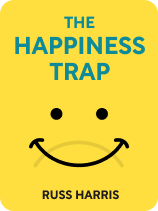

This article is an excerpt from the Shortform book guide to "The Happiness Trap" by Russ Harris. Shortform has the world's best summaries and analyses of books you should be reading.
Like this article? Sign up for a free trial here .
What is urge surfing? How can practicing the urge surfing technique help you resist the impulse to perform unwanted behaviors?
Urge surfing is a therapeutic technique for dealing with unwanted urges. It’s based on the idea that most urges won’t persist for longer than 30 minutes, provided that we don’t give in to the urge or “refresh” it by giving it attention or fighting it.
Keep reading to learn about the concept of urge surfing and how it can help you resist unwanted behavior.
“Urge Surfing”: Fight Your Urges
Emotions frequently have two components: physical sensations and action tendencies (also called urges). In his book The Happiness Trap, Russ Harris explains that when we have urges associated with negative emotions, they’re often tied to the control strategies that keep us in the happiness trap.
While expansion in its ordinary form deals primarily with the first component, sensations, a slight adaptation of the technique—called urge surfing—addresses the second component, urges. Just as expansion helps you accept an uncomfortable sensation, urge surfing helps you accept difficult urges.
Harris details the five steps of urge surfing:
- Use your observing self to connect with the urge in your body.
- Use your thinking self to recognize and name the urge. For example, you might say: “I’m experiencing the urge to—”
- Use deep breathing to explore the urge and make room in your body for it. (Shortform note: You’ll notice that this step combines steps 2 and 3 of expansion, so you could argue that we should consider urge surfing a six-step process.) Avoid the temptation to try to eliminate this negative feeling.
- Tolerate the urge and observe it as it changes. If your thinking self intercedes, practice defusion techniques. You can also repeat step 2 of the urge surfing process (recognize and name the urge) intermittently.
- Decide an appropriate course of action. Consider your values and try to act in a way that is consistent with them.
(Shortform note: We haven’t fully covered the ACT principles meant to guide step 5 in the process above, so it may be useful to revisit this technique after reading this guide’s chapter on values.)
Urge Surfing Reframes Urges
Urge surfing is not a practice specific to ACT. Rather, it’s a standard part of the therapeutic repertoire for addiction treatment all over the world.
People often use different water metaphors to explain urges:
Some people describe an urge as an ocean wave, which rises, crests, and dissipates. Like waves, urges can vary in size, from small to massive, but you can treat your breathing as your “surfboard” as you ride the wave of the urge. Others describe an urge as a riptide that sweeps swimmers away from the shore. If you try to swim against the current of a riptide, you become too tired and eventually drown. On the other hand, if you surf the urge, you swim parallel to the shore, you can escape the area of the riptide and find your way back to the beach. Others describe an urge as a waterfall crashing down from unseen heights. If you put your body in the way of the waterfall, it will overwhelm you—but urge surfing allows you to step out of the path of the waterfall and watch the water pass by.
Some practitioners of urge surfing say that focusing on one of these metaphors while you urge surf can help you focus and put your problem—that your urge seems uncontrollable—into perspective.

———End of Preview———
Like what you just read? Read the rest of the world's best book summary and analysis of Russ Harris's "The Happiness Trap" at Shortform .
Here's what you'll find in our full The Happiness Trap summary :
- Why trying to be happy is making you unhappy
- How to practice ACT, or Acceptance and Commitment Therapy, to become happier
- How to develop “psychological flexibility” toward negative feelings instead of eliminating them






